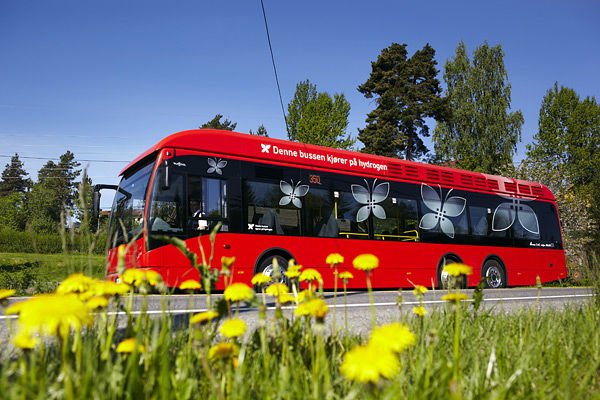
Hydrogen and renewable energy sources complement each other.
Hydrogen: A new market on its way
When the industry sector needs to go green, hydrogen will be a preferred alternative to fossil fuels. In transportation, battery power works fine for passenger electric cars, but when ships and trucks are to be electrified, hydrogen is a better alternative for the long and heavy routes.
Green or blue hydrogen?
Despite being the most common element in the universe, hydrogen does not exist in free form on Earth. If we need hydrogen, we must produce it ourselves, either by electrolysing water or by separating it from fossil fuels like coal or natural gas.
Hydrogen produces no greenhouse gas emissions when burned, but the method used to produce it can determine how environmentally friendly it is.
"Today hydrogen is usually produced from fossil fuels, primarily because it's the cheapest method available. The drawback is that it not only produces hydrogen; it also leaves you with CO2, and some methane will escape in the process. If this method is to be made more sustainable, we need to combine hydrogen production with carbon capture and carbon storage – so called ‘blue hydrogen’ – and at the same time limit methane emissions. We're not there yet, because this requires huge facilities and investments. And besides, producing blue hydrogen will always result in some emissions. Statkraft is a renewable electricity producer, that's why we in Statkraft focus on producing 'green hydrogen' which also has the advantage of zero emissions," says Bjørn Holsen, who is senior vice president of the hydrogen department in Statkraft.
Green hydrogen produced with renewable electricity does not emit CO2 or methane. Green hydrogen can also be produced close to the offtake, either for transportation or for industrial use.
Local production of green hydrogen suits well when the process industry requires solutions to remove the current use of fossil fuels, for example in high-temperature heating processes. And when something heavy needs to be transported over long distances by road, rail, sea or air, locally produced green hydrogen also has a role to play. Blue hydrogen would need bigger offtakes and probably pipeline solutions. This also means that blue and green hydrogen could be used in different markets and for different kinds of use.
In practice, converting to hydrogen using electrolysis leaves us with 70-75 per cent of the available energy. New technologies can increase this to 85 or maybe over 90 per cent. But where hydrogen is used, is also of importance. In heavy duty transport the efficiency would typically be between 40 and 55 per cent, but in the industrial sector it could be as high as 80 per cent. If we can manage to use the heat, for example, in district heating, this would boost hydrogen efficiency significantly.
Since electric power is the most expensive factor in green hydrogen production, it is an advantage to have a ready supply of affordable renewable electricity and the ability to produce hydrogen when electricity prices are at their lowest.

Decarbonising the transport and industry sector
Hydrogen is quickly becoming an important solution to reduction of greenhouse gas emissions in the industry sector. Today different kinds of fossil fuels are used as feedstock and high temperature heat source in industrial processes. For some of these processes green hydrogen could be the solution to cut emissions. Green hydrogen could for instance be used as a reduction agent in steel production.
Hydrogen based on natural gas, often referred to as 'grey hydrogen', is widely used in ammonia production. Ammonia is an important ingredient in fertilizer production. So, if grey hydrogen could be replaced with green hydrogen you could have green fertilizers production – which again will make food chains more sustainable.
"The greenhouse gas emissions from the industry sector need to be reduced quickly. Transition to clean hydrogen is great for the planet, but also good for business. By developing hydrogen production facilities, Statkraft could offer solutions that could help the needed industrial transition around the globe. We have a plan – we want to get into the industrial processes to get the fossil fuels out," says Holsen.

Bjørn Holsen leads the Hydrogen department in Statkraft's New Energy Solutions business area.
How a fuel cell works

-
A fuel cell is a battery that directly converts a combustible element into electricity. The combustible element can be hydrogen gas, methanol or ethanol.
-
A fuel cell has two electrodes immersed in an electrolyte. The combustible element, for example hydrogen, enters one of the electrodes (the negative pole) and releases electrons to it. Simultaneously, the element reacts with the electrolyte during formation of H+ ions. Air or oxygen is added to the other electrode (the positive pole), causing the electrode to release electrons (electricity). The oxygen is reduced when OH-ions form in the electrolyte and react with the H+ ions to produce water.
-
Fuel cells are extremely effective. An internal combustion engine has an energy efficiency of around 35 per cent, and a steam turbine of around 50 per cent, whereas a fuel cell has a theoretical maximum energy efficiency of close to 100 per cent. Currently, however, efficiency between 50 and 60 per cent is a good result.
(Source: Store norske leksikon)
The shipping industry needs to cut emissions
Hydrogen has the potential to play an important role in the decarbonisation of shipping in the coming years and decades.
The shipping sector generally tends to be quite conservative and there are long lead times for building new ships. However, there are several developments both from a regulatory perspective and from consumer demand that have started to push in the direction of using cleaner fuels.
A large segment of the maritime sector will be included in the EU Emissions Trading System (EU ETS) from 2024, which will make emissions more costly. In Norway, there are plans to increase CO2 taxes to 2,000 NOK per tonne CO2 by 2030 and to ensure that all new ferry and high-speed passenger ship tenders are low or zero-carbon by 2023 and 2025 respectively.
There are already several ferries operating with battery, but longer distance routes will require hydrogen. Several hydrogen ferry projects are currently being realised or under planning. Compressed hydrogen is significantly cheaper than liquid hydrogen and is well suited to both the ferry segment, but also for coastal bulk and container ships. Hydrogen can either be stored in pressurised containers that are swapped on and off ships or filled via specialised hoses.
“Ships that have a high energy requirement, for example that are larger or need to be out at sea for a long time, require a more energy-dense fuel. The most discussed fuels in shipping are low carbon methanol and ammonia, both of which are produced from hydrogen,” Holsen explains.
Ammonia is considered a potential shipping fuel in the future as it can be completely CO2-free. However, the downsides include toxicity levels that will require high safety measures and a lack of engines and fuel cells that can use ammonia, although these are under development. Methanol is seen as a good solution to use in the short term as there are less safety issues compared to ammonia. Methanol is also liquid at more normal temperatures and the engines and bunkering infrastructure are already available. The potential downside is that methanol is not a zero-carbon fuel and there is a limited supply of green or bio-methanol available today.
“We see a large interest for methanol deep-sea container ships, and both methanol and ammonia ships are now being considered within the offshore supply segment. The future looks bright and green for the shipping industry,” says Holsen.

A need for large vehicles
Within road transport, Statkraft is focusing on the heavy-duty part of the sector, and mainly on trucks. Experience over the past years has shown that the electrification (i.e., battery electric) of passenger cars and even bus fleets is working well.
Statkraft expects part of the heavy-duty truck market to use hydrogen and continues to keep a close eye on the development of this market segment, especially what the original equipment manufacturers (OEMs) are doing and what they will offer soon.
Statkraft intends to take a role in this market segment and will consider developing infrastructure as the market gradually emerges.
Authorities also have a role to play here, and the new EU Alternative Fuels Infrastructure Regulation (AFIR) could possibly be kick starting the market for hydrogen trucks.
According to Bjørn Holsen, there is strong interest in zero-emissions vehicles among private transport companies, and the level of interest is intensified by further requirements to reduce emissions by 2030.
"There are a lot of exciting things going on right now, and Statkraft has every intention to play a part in moving the zero-emission market forward," says Holsen.
Electrolysis – alkaline and PEM
- Alkaline electrolysers are world leading and relatively cheap to produce. They have a long life-cycle and low maintenance costs. Moreover, they can be produced in large units that can produce large volumes of hydrogen. One drawback is their relatively long response time, which makes it difficult to combine them with variable energy supply.

- PEM (proton-exchange membrane) electrolysis is available in more compact and generally more effective units, where the electrolyte is a solid proton-conducting membrane. PEM can be placed under pressure, and different pressure levels can be applied to each electrode. The system has a higher conduction current density and smaller footprint, and because it can be placed under pressure there is no need for a compressor. Its low response time makes it ideal in combination with variable energy sources such as solar and wind.
(Source: energiogklima.no)
Hydrogen can be stored
Hydrogen can also be used as an energy carrier and a 'battery' in the energy sector. It can be converted back into power using fuel cells or gas turbines when there are extended periods with low wind and solar PV production.
This is likely to occur more often in the future, as we continue to build more intermittent renewable sources of power.

Public support needed in a transition phase
Cost reductions in renewable energy and hydrogen technologies – electrolysers and fuel cells – will make green hydrogen applications more cost-competitive to direct use of fossil fuels. The value chains for hydrogen have not reached full market maturity, and public support is still needed.
An important market enabler is to facilitate the decrease in cost of electrolysers and have policy incentives such as carbon taxes or subsidies. Policy frameworks and regulations can accelerate the growth in electrolyser capacity and green hydrogen production, and thus contribute to increase costs for fossil alternatives.
Green hydrogen needs incentives, and providing financial support that enables scaling and operation is important. In a build-up phase, electrolysers must be able to receive investment aid. This will contribute to reducing the first movers' disadvantage.
Related articles

REPowerEU: Green EU transition speeds up
A few weeks after Russian forces entered Ukraine in February 2022, the European Commission launched the energy plan REPowerEU. In a short time, it will free the EU from Russian oil and gas and speed...
Read more

Hydrogen: A new market on its way
When the industry sector needs to go green, hydrogen will be a preferred alternative to fossil fuels. In transportation, battery power works fine for passenger electric cars, but when ships and trucks...
Read more

Energy solution: Renewable proposal for Svalbard
The island community of Svalbard, lying between Norway and the North Pole, currently receives its electricity from a coal power plant. But what happens when the coal is gone and Svalbard must become...
Read more